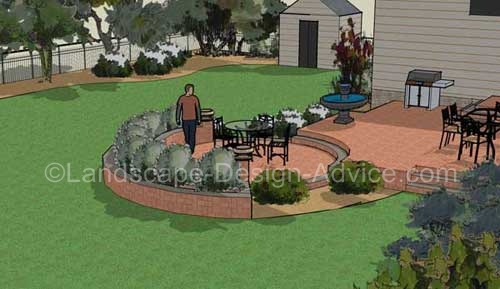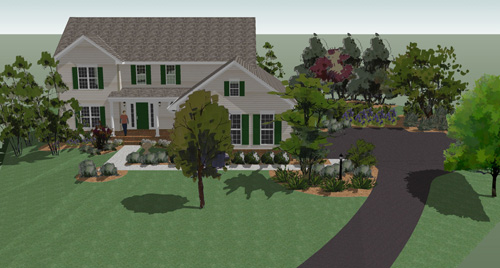












There 's an old saying that states something like - "Getting started is" half-finished. And so many times I find this to be true as I see you do it yourself landscapers struggle to find their initial design idea. However, once you establish a framework of necessary elements of design, usually goes pretty smooth from there.
Does "not surprisingly the 's the most common question of landscape design that it is where do I begin? Is the "or" how do I start my design? . I know it can be difficult. And especially if you do 't have a vision for your design.

So where do you start? How do you start your landscape or garden design?
While each design is different and every designer follows a set of rules and principles, I find that most do it yourselfers that everything is the greatest success using the same starting point. Begin by placing any roads, driveways, paths or walking area that might be needed. And also create access to any area that you can plan to create. In many designs, this will help establish a framework that you can design just about.
Of course, that the 'won t be applicable in all designs as many sets the' t require any access or travel. Take this advice and use as where and if you can.
The roads and walkways can accomplish many functions in your landscape or garden. Its main function, of course, is to create a space designated for people browse on.
However, in design and as an aid to design, their role could be to direct visitors, with or away from some other area in the garden. Also, they are a great way to break up a vast expanse of lawn, meadow, or bed area.

First, look at the highways, roads, and such necessary items.
The roads are needed to direct visitors or yourself to and from another area. Notice that almost every home has a driveway lead to the main door, which is, of course, where most people want to invite guests to come. So walks are refined (brick, tile, etc..) Or primitive (gravel, mulch, etc..) Are needed to "direct" or "lead" to visitors, with or away from an area.
So where are the necessary areas where you need other walkways or access? Maybe the back entrance to the alley where you empty the trash. Or from the house to the pool area. Or the pool area to area kids play area or outdoor cooking. You get the picture.

In a design sense.
Setting the walk, drive, and access areas in turn will help create the borders and boundaries. Once you make your roadways present, you can design just much landscaping around them. The same goes with driveways and parking too. You can plant beds on either or both sides of a walk or use as a roadway edge to create borders.
Keep it interesting if you can.
If you were to, for example, plan to put a sitting area in the back of the garden. Of course you would need some type of way for you and your guests get there. "But instead of drawing a straight path, why not create a trip coil with other interesting areas of the garden on the way there?
Curves and winding paths to do more than just create interest. They can also create an illusion of more space, distance, and travel. This is especially useful in creating small gardens and landscapes.
Once you place the roadways, driveways, and access areas, you have a good framework to start for the rest of the design. Now, simply design around them.

New landscape design software for creating professional plans and presentations. Design houses, decks, fencing, yards, gardens, swimming pools, water features, and much more with easy-to-use tools. Give your plans a hand-drawn look using a wide variety of plant symbols and color washes. Add plant labels automatically using the wizard, and add a plant legend with just a few mouse clicks. Design irrigation systems, planting details, and other CAD drawings with accurate size and scale. Includes drawing templates for sheet sizes A0-A4, and custom sizes are also supported. An extensive library of symbols is included, and you can create your own using the wizard. Freely switch between 2D and 3D views while designing your landscape. Design houses, decks, and other objects in 2D, and then switch to 3D to set their elevation. Import a digital photograph of your clients house and design the landscape. Present before-and-after views to help your client visualize your landscaping ideas. A powerful picture editor is included so you can touch-up photos, edit imported pictures, and even create custom plant varieties. Freely walk around your landscape designs in real-time 3D. Advanced rendering features include soft shadows, accurate lighting, flowing water, and more. The full version includes over 12,800 objects, including 5700 highly detailed plants such as trees, shrubs, flowers, water garden, cactus, palms, and more. Plant information includes common name, botanical name, planting zones, and size.
Realtime Landscaping Architect 2 Trial (Version 2.04 ) is Demo and is 371000 bytes in size. New landscape design software
Realtime Landscaping Architect 2 Trial Requires: WinXP,Windows Vista Starter,Windows Vista Home Basic,Windows Vista Home Premium,Windows Vista Business,Windows Vista Enterprise,Windows Vista Ultimate,Windows Vista Home Basic x64,Windows Vista Home Premium x64,Windows Vista Business x64,Windows Vista Enterprise x64,Windows Vista Ultimate x64
 Download Realtime Landscaping Architect 2 Trial
Download Realtime Landscaping Architect 2 Trial

No comments:
Post a Comment